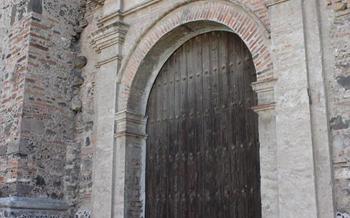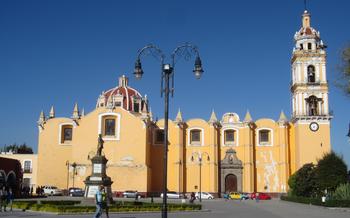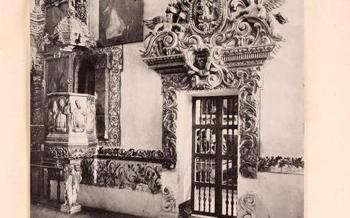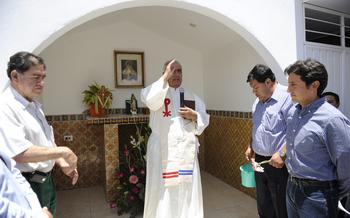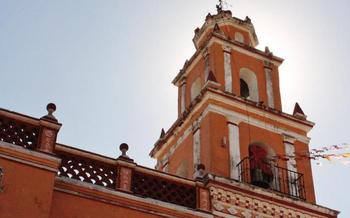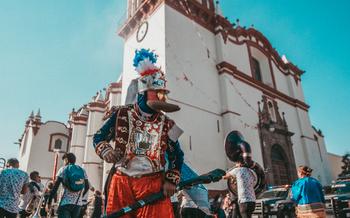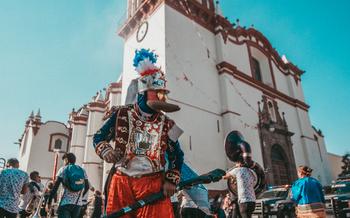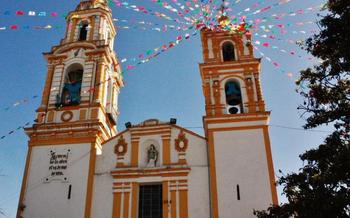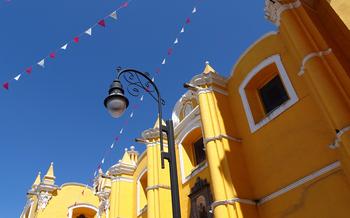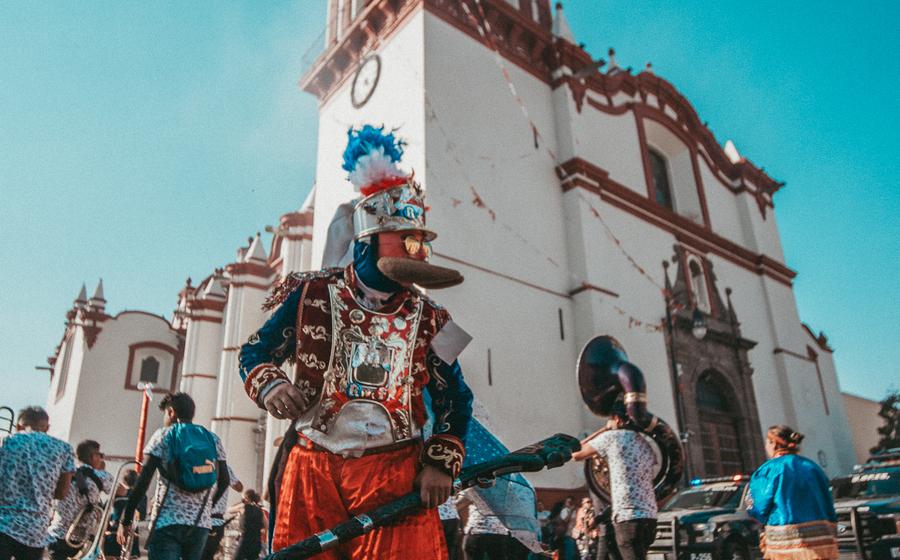
Templo de San Rafael Comac
- Templo de San Rafael Comac: A Hidden Gem in Cholula
- A Living Community: The Integration of Faith and Culture
- Legends and Mysteries: Unveiling the Hidden Stories
- The Cholula Burial Cave: A Glimpse into the Past
- The Sanctuary of Our Lady of Remedies: A Majestic Landmark
- The City of Cholula: A Tapestry of History and Culture
- Interactive Workshops: Embracing Local Traditions
- The Great Pyramid of Cholula: An Ancient Wonder
- Discovering Local Cuisine: Flavors of Cholula
- The Parroquia de San Pedro: A Colonial Masterpiece
- The Convent of San Gabriel: A Haven of Peace
- The Ex-Convent of San Francisco Acatepec: A Hidden Treasure
- Museo Regional de Cholula: A Journey Through History
- Insider Tip: Exploring Beyond the Tourist Trail
Templo de San Rafael Comac: A Hidden Gem in Cholula
, stands a hidden gem that captivates the souls of travelers and pilgrims alike: the Templo de San Rafael Comac. This sacred edifice, with its intricate murals and profound religious significance, is a testament to the deep-rooted faith and artistry of the local community.
Religious significance
The Templo de San Rafael Comac holds a special place in the hearts of the local Catholic community. Dedicated to the Archangel Raphael, the patron saint of travelers and healers, the church has been a place of worship and pilgrimage for centuries. Believers flock to the temple, seeking solace, guidance, and divine intervention. The church's sacred ambiance and stunning artwork create an atmosphere of reverence and spirituality, making it a sanctuary for the faithful.
Local legends and anecdotes
The Templo de San Rafael Comac is not just a religious site; it's also a repository of local legends and anecdotes that have been passed down through generations. One captivating tale speaks of a golden bell that once adorned the church's bell tower. Legend has it that the bell possessed miraculous powers and would ring on its own accord to warn the townspeople of impending danger. The bell, unfortunately, was stolen by bandits, and its whereabouts remain a mystery to this day.
A Living Community: The Integration of Faith and Culture
The Templo de San Rafael Comac is not merely a religious site; it is a vibrant community hub where faith and culture are deeply intertwined. Daily life in the community revolves around the church, with locals gathering for prayers, festivals, and social events. Religious traditions are meticulously preserved, including processions, novenas, and special masses.
The integration of indigenous and Catholic beliefs is a unique characteristic of the community. The church incorporates pre-Hispanic symbols and imagery, acknowledging the region's rich cultural heritage. This fusion of beliefs has shaped the community's identity, creating a unique blend of spirituality and tradition.
The church plays a crucial role in fostering a sense of unity and belonging among the community members. It provides a space for communal gatherings, decision-making, and sharing of stories and traditions. The Templo de San Rafael Comac is not just a place of worship; it is the heart of a community that thrives on its shared faith and cultural heritage.
Legends and Mysteries: Unveiling the Hidden Stories
Legends and mysteries are an integral part of the cultural tapestry of Cholula and the Templo de San Rafael Comac. One of the most captivating tales is the legend of the golden bell. According to local lore, a golden bell once hung in the church, but it was stolen by pirates who tried to melt it down. However, the bell miraculously reappeared in the church, untouched and undamaged.
Mysterious apparitions and miracles are also associated with the temple. Many locals believe that the Virgin Mary has appeared in the church on several occasions, performing miracles and granting wishes. The church has also been the site of unexplained phenomena, such as the movement of statues and the appearance of strange lights.
Over the years, the Templo de San Rafael Comac has collected a trove of unsolved puzzles and mysteries. One of the most intriguing is the question of why the church was built on such a small plot of land. Some believe that the church was originally much larger, but that parts of it were destroyed by earthquakes or floods. Others speculate that the church was built on a sacred site, and that the small size of the plot was intentional.
Faith and spirituality play a vital role in the community surrounding the Templo de San Rafael Comac. Many locals believe that the church is a sacred place with a powerful energy. They come to the church to pray, to seek solace, and to witness the many miracles that are said to occur there. The church is a reminder of the power of faith and the enduring strength of the human spirit.
The Cholula Burial Cave: A Glimpse into the Past
In the heart of Cholula, lies a hidden treasure that unveils the ancient secrets of pre-Hispanic civilizations - the Cholula Burial Cave. Discovered in 1994 during construction work, this remarkable site has become a crucial window into the past, offering invaluable insights into the burial practices and rituals of ancient Mesoamerican cultures.
Home to over 500 human remains, along with a wealth of artifacts, including pottery, jewelry, and tools, the cave provides a glimpse into the lives and beliefs of the region's early inhabitants. Scientists believe that the cave served as a communal burial ground, where members of the community were laid to rest with their personal belongings, symbolizing their journey into the afterlife.
The discovery of the cave has shed light on the complex social and religious practices of pre-Hispanic cultures in Cholula. It has also contributed to our understanding of the region's history, as the artifacts found within the cave offer valuable clues about the daily lives, customs, and rituals of the ancient people who called this land their home.
The Sanctuary of Our Lady of Remedies: A Majestic Landmark
Majestically perched atop a hill overlooking the city of Cholula, the Sanctuary of Our Lady of Remedies stands as a testament to faith, devotion, and architectural grandeur. This iconic landmark is considered one of Mexico's most important pilgrimage sites and attracts millions of visitors annually.
The sanctuary's history dates back to the 16th century when Spanish conquistadors built a small chapel on the site. However, it was in the 17th century that the sanctuary was expanded and transformed into the magnificent structure we see today. The construction was overseen by the Augustinian friars, who played a significant role in spreading Catholicism throughout the region.
The sanctuary is renowned for its stunning architecture, which blends Renaissance and Baroque elements. Its facade is adorned with intricate carvings and sculptures, while the interior boasts beautifully crafted altars, murals, and stained-glass windows. The sanctuary's most striking feature is its dome, which dominates the skyline and can be seen from miles around.
The sanctuary is dedicated to Our Lady of Remedies, a venerated figure in Mexican Catholicism. According to legend, the Virgin Mary appeared to a local indigenous man in the 16th century, instructing him to build a chapel on the hilltop where he had encountered her. The sanctuary became a popular pilgrimage site, and many miracles and blessings have been attributed to Our Lady of Remedies over the centuries.
Every year, on September 8th, the sanctuary celebrates the feast day of Our Lady of Remedies with a grand pilgrimage. Thousands of pilgrims from all over Mexico and beyond flock to Cholula to pay homage to the Virgin Mary and participate in the festivities. The pilgrimage is a vibrant display of faith and devotion, featuring processions, masses, and traditional dances.
From the hilltop sanctuary, visitors can enjoy breathtaking panoramic views of the city of Cholula, the surrounding countryside, and the majestic volcanoes Popocatépetl and Iztaccíhuatl in the distance. The sanctuary's serene ambiance and stunning vistas make it a popular destination for both pilgrims and tourists seeking a moment of tranquility and reflection.
The City of Cholula: A Tapestry of History and Culture
Cholula, nestled in the heart of Mexico, is a vibrant city steeped in history and culture, offering visitors a unique blend of ancient heritage and modern charm. Once a thriving pre-Hispanic settlement, Cholula boasts a rich history that dates back to the 2nd century BC. As a major religious center, it was home to over 100 temples, earning it the title of "the City of Churches."
The city's rich tapestry of history is evident in its numerous cultural attractions and landmarks. Visitors can explore the ancient ruins of the Great Pyramid of Cholula, the largest pyramid in the world by volume, and admire its impressive size and architectural ingenuity.
In the historic center, the Parroquia de San Pedro, a stunning colonial masterpiece, stands as a testament to the city's religious heritage. Its intricate facade and vibrant frescoes captivate visitors, providing a glimpse into Cholula's colonial past.
Vibrant local markets, such as the Mercado Municipal de Cholula, offer a kaleidoscope of colors, scents, and flavors. Here, visitors can immerse themselves in the local culture, browse traditional crafts, and savor delicious regional delicacies, including the world-famous mole poblano, a complex and flavorful sauce that has become synonymous with Cholula's culinary heritage.
Cholula's significance in Mexican history is undeniable. As a major trading and religious center, it played a pivotal role in the development of pre-Hispanic Mesoamerican civilizations. Its strategic location made it a crossroads for various cultures, resulting in a rich blend of traditions and beliefs that continue to shape the city's identity today.
Whether you're a history buff, a cultural enthusiast, or simply seeking a unique and authentic Mexican experience, Cholula is a city that will captivate your senses and leave you with lasting memories.
Interactive Workshops: Embracing Local Traditions
Cholula offers a unique opportunity to immerse yourself in the region's rich cultural heritage through interactive workshops. These workshops provide a hands-on experience, allowing you to learn traditional crafts and techniques from local artisans and craftspeople.
From pottery and textile weaving to the intricate art of papel picado (paper cutting), these workshops offer a glimpse into the creative soul of Cholula. You can work alongside skilled artisans, learning the secrets of their craft and creating your own unique pieces to take home as souvenirs.
Whether you're a seasoned artist or simply looking for a fun and engaging way to experience Cholula's culture, these workshops are a must-do. They provide an immersive and interactive way to connect with the local community and gain a deeper appreciation for the region's artistic traditions.
Insider Tip:
-
Be sure to book your workshop in advance, especially if you're interested in a specific craft or technique.
-
Ask your instructor about the history and significance of the craft you're learning. This will help you gain a deeper understanding of the cultural context behind the art form.
-
Consider purchasing some of the artisans' finished products as souvenirs. This is a great way to support the local economy and take home a piece of Cholula's creativity.
The Great Pyramid of Cholula: An Ancient Wonder
Rising majestically from the heart of Cholula, the Great Pyramid, also known as Tlachihualtepetl, stands as a testament to the ingenuity and architectural prowess of ancient civilizations. Its construction began around the 3rd century BC and continued for several centuries, making it the largest pyramid in the world by volume. The pyramid's base measures an impressive 450 by 450 meters, and it rises to a height of 66 meters, comparable to the Great Pyramid of Giza in Egypt. Despite its grandeur, the pyramid remained hidden for centuries beneath a thick layer of vegetation and soil, earning it the nickname "Sleeping Giant."
The pyramid's unique structure and design set it apart from other ancient pyramids. Instead of a smooth, steep exterior, it features a series of superimposed platforms or terraces, creating a stepped appearance. Archaeologists believe that the pyramid was built in several stages, with each subsequent layer constructed on top of the previous one. The pyramid's interior is a labyrinth of tunnels and chambers, some of which have been excavated and opened to the public.
The Great Pyramid of Cholula holds immense archaeological significance. Excavations have revealed a wealth of artifacts, including pottery, figurines, and tools, providing valuable insights into the lives and beliefs of the ancient civilizations that built and inhabited the pyramid. The pyramid's construction techniques and architectural features have also been the subject of extensive study, shedding light on the advanced engineering skills of the ancient builders.
Myths and legends surround the Great Pyramid of Cholula, adding to its mystique and allure. According to one legend, the pyramid was built by a giant named Xelhua, who was tasked with reaching the heavens to retrieve fire for his people. Another legend tells of a great flood that threatened to destroy the world, and the pyramid was built as a refuge for the gods and humans to escape the rising waters.
The pyramid remains an active site of archaeological research and exploration. Ongoing excavations continue to uncover new secrets and provide valuable insights into the ancient world. The Great Pyramid of Cholula stands as a symbol of Mexico's rich cultural heritage and a reminder of the ingenuity and creativity of our ancestors.
Discovering Local Cuisine: Flavors of Cholula
Cholula's cuisine is a delightful blend of indigenous and colonial influences, offering a culinary journey that tantalizes the taste buds. The city's signature dish is mole poblano, a rich and complex sauce made with over 20 ingredients, including chocolate, chili peppers, and spices. This delectable sauce is often paired with chicken or turkey and served with rice and tortillas. Other regional specialties include chalupas, a crispy tortilla topped with shredded chicken, salsa, and cheese; cemitas, a type of sandwich made with a sesame seed bun, milanesa (breaded cutlet), and various fillings; and tlayoyos, thick corn tortillas filled with beans, cheese, or squash blossoms.
For a taste of authentic Mexican street food, head to the Mercado Municipal, a bustling market filled with colorful stalls selling fresh produce, traditional dishes, and local delicacies. Here, you can sample a variety of tacos, tamales, and quesadillas, all made with fresh, local ingredients.
For a fine dining experience, visit one of Cholula's many restaurants, which offer a range of culinary delights from traditional Mexican cuisine to international flavors. Be sure to try the local pulque, a traditional fermented beverage made from the sap of the maguey plant.
Cholula's culinary scene is a testament to the city's rich cultural heritage and its vibrant present. Whether you're seeking authentic street food or fine dining, Cholula has something to offer every palate.
The Parroquia de San Pedro: A Colonial Masterpiece
In the heart of Cholula, stands the Parroquia de San Pedro, a magnificent testament to the city's colonial heritage. Constructed in the 16th century, this awe-inspiring church is renowned for its architectural splendor and intricate frescoes that adorn its walls and ceilings. A symbol of the city's deep-rooted Catholic faith, the Parroquia played a pivotal role in the evangelization of Cholula, serving as a beacon of Christianity in the region.
Beyond its religious significance, the Parroquia de San Pedro is an architectural masterpiece, showcasing the fusion of European and indigenous influences. Its grandiose façade, adorned with intricate carvings and sculptures, reflects the grandeur of the Spanish Baroque style. Step inside, and you'll be captivated by the radiant interior, where vibrant frescoes depict scenes from the Bible and the lives of saints, creating a breathtaking visual narrative.
The Parroquia de San Pedro stands as a testament to the artistic prowess and devotion of the people of Cholula. Its enduring legacy continues to inspire and captivate visitors from around the world, making it a must-see destination for anyone seeking to delve into the rich history and cultural heritage of this captivating city.
The Convent of San Gabriel: A Haven of Peace
In the heart of Cholula, nestled amidst cobblestone streets and colorful colonial buildings, lies the Convent of San Gabriel, a sanctuary of tranquility and architectural splendor. Founded in the 16th century by Franciscan friars, this historic convent has stood the test of time, serving as a spiritual haven and a testament to the city's rich religious heritage.
As you step through the convent's gates, a sense of serenity envelops you, inviting you to leave behind the hustle and bustle of the city. The courtyard, adorned with lush greenery, provides a tranquil oasis, where the gentle murmur of the fountain creates a soothing ambiance. The convent's architecture, a harmonious blend of Gothic and Renaissance styles, captivates the eye with its intricate stonework, graceful arches, and elegant columns.
The interior of the convent is equally captivating, showcasing a collection of religious art that spans centuries. From the intricately carved wooden altars to the vibrant frescoes adorning the walls, each piece tells a story of faith, devotion, and artistry. The main altarpiece, a masterpiece of Baroque art, is a testament to the skill and dedication of the artisans who created it.
Beyond its artistic treasures, the Convent of San Gabriel is also a place of profound spiritual significance. For centuries, it has been a center of worship and contemplation, where generations of believers have sought solace and guidance. The convent's peaceful atmosphere and the presence of the Franciscan friars create an environment conducive to reflection and renewal.
Whether you are a history buff, an art enthusiast, or simply seeking a moment of tranquility, the Convent of San Gabriel is a must-visit destination in Cholula. This hidden gem offers a glimpse into the city's rich religious heritage and invites visitors to experience the peace and serenity that have defined this sacred space for centuries.
The Ex-Convent of San Francisco Acatepec: A Hidden Treasure
Nestled amidst the tranquil streets of Cholula, the Ex-Convent of San Francisco Acatepec stands as a testament to the city's rich history and architectural heritage. Founded in the 16th century by Franciscan missionaries, the convent served as a religious and educational center for over two centuries. However, in the 19th century, the convent was abandoned and fell into disrepair.
Despite its dilapidated state, the Ex-Convent of San Francisco Acatepec retains its charm and historical significance. The convent's architecture is a blend of Gothic and Renaissance styles, featuring intricate stone carvings, vaulted ceilings, and a spacious courtyard. Although the convent is no longer in use, visitors can still admire its impressive facade and explore the ruins of the interior.
In recent years, efforts have been underway to restore the Ex-Convent of San Francisco Acatepec to its former glory. The restoration project aims to preserve the convent's architectural features, uncover hidden treasures, and create a vibrant cultural space for the community. Once completed, the Ex-Convent of San Francisco Acatepec will serve as a museum, showcasing the convent's history and its role in the development of Cholula.
For those seeking an off-the-beaten-path experience, the Ex-Convent of San Francisco Acatepec is a must-visit. Its unique charm and historical significance make it a hidden gem in Cholula, waiting to be discovered by curious travelers.
Museo Regional de Cholula: A Journey Through History
The Museo Regional de Cholula, nestled in the heart of the city, invites visitors to embark on a captivating journey through time. Within its walls, a diverse collection of artifacts and exhibits unveils the rich tapestry of Cholula's past, from its pre-Hispanic origins to its colonial legacy.
Interactive displays and educational programs bring history to life, immersing visitors in the captivating stories of Cholula's ancient civilizations and the profound impact of Spanish colonization. Through carefully curated exhibits, the museum showcases the region's vibrant cultural heritage, shedding light on its traditions, customs, and artistic expressions.
A visit to the Museo Regional de Cholula is an essential experience for anyone seeking to delve deeper into the fascinating history and cultural legacy of this remarkable city. Here, visitors can gain a profound appreciation for the diverse influences that have shaped Cholula's unique identity, leaving them with a lasting impression of its enduring spirit.
Insider Tip: Exploring Beyond the Tourist Trail
Venture beyond the popular tourist attractions to discover Cholula's hidden gems. Explore the vibrant local markets, where you can find unique souvenirs and authentic crafts. Engage with the friendly locals, who are always willing to share stories and insights into their culture. Immerse yourself in traditional festivals and celebrations, where you can witness the city's rich heritage and traditions come alive. Take the time to wander through the charming cobblestone streets, where you may stumble upon hidden plazas, historic churches, or beautiful murals that tell the story of Cholula's past. By stepping off the beaten path, you'll gain a deeper appreciation for the city's diverse cultural tapestry and create memories that will last a lifetime.
